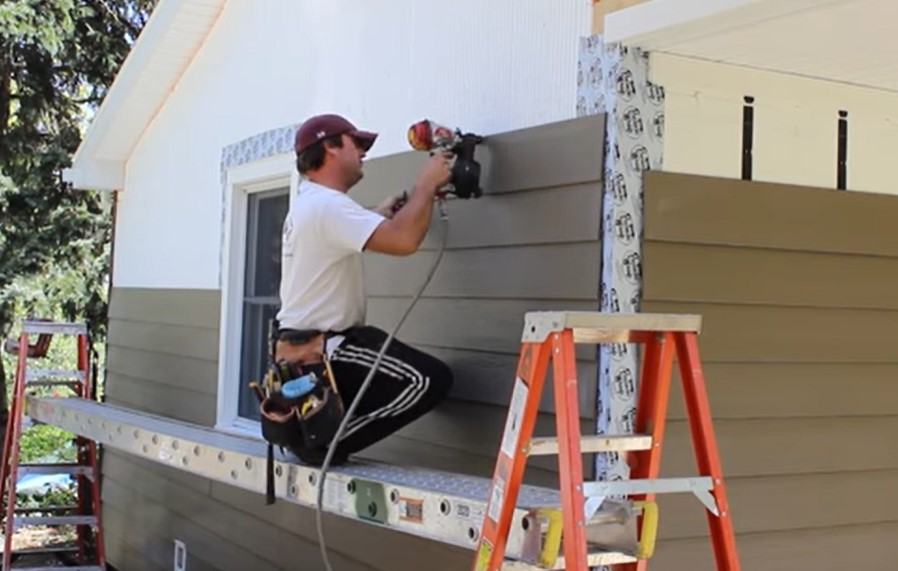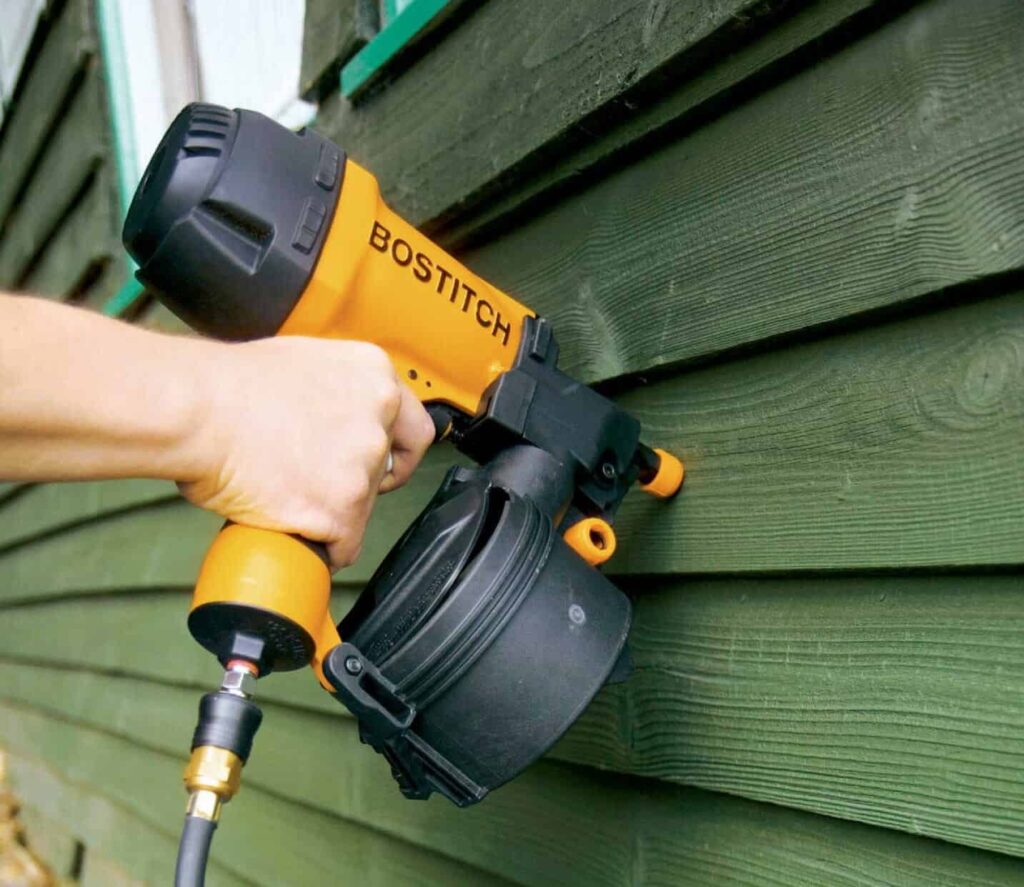As a professional contractor or DIY enthusiast looking to install Hardie siding, you may be wondering if it’s possible to use a finish nailer for this kind of application. Hardie siding is a high-quality fiber cement material that is designed to withstand harsh weather conditions and last for many years without needing repair or replacement. However, installing it can be a challenging task, and you need to be sure that you are using the right tools for the job.
Using a finish nailer on Hardie siding is a common question that many people ask, and the answer is not as straightforward as you might think. While a finish nailer can be used to install Hardie siding, there are several factors that you need to consider to ensure that the installation is successful, safe, and long-lasting. One of the most important factors to consider is the type of nails you use.
In this blog post, we will explore whether using a finish nailer on Hardie siding is a viable option, the pros and cons of using a finish nailer, and provide tips on the best practices for installing this siding material to ensure a long-lasting and beautiful finish for your home.
What Is Hardie Siding?
Hardie siding, also known as James Hardie siding, is a type of siding material made from a blend of cement, sand, and cellulose fibers. This type of siding is known for its durability, as it is resistant to fire, water damage, and insects. Hardie siding comes in a variety of styles and textures, including lap siding, shingle siding, and vertical siding.
It is a popular choice for homeowners who want a low-maintenance option that will last for years. Hardie siding is also available in a range of colors, making it easy to match the exterior of any home.
Overall, Hardie siding is a reliable and attractive choice for those looking to improve the exterior of their home.
What Is A Finish Nailer?
A finish nailer is a power tool commonly used in delicate carpentry and woodworking projects. It is designed to shoot small, thin nails known as finish nails (usually 1 to 2-½ inches long and 15 to 16 gauge thickness), which are typically used to attach trim and molding to walls, cabinets, and furniture.
Finish nailers are used to apply a professional-looking finish to any woodworking project, leaving behind a clean and polished appearance. These tools are available in various sizes and styles, each designed for a specific type of job.
They are typically air-powered, but some models are cordless and battery-operated. Based on the magazine angle they can be straight or angled style.
It is an essential tool for any professional carpenter or DIY enthusiast looking to achieve precision and accuracy in their woodworking projects.
How Does A Finish Nailer Work?
A finish nailer is a tool that is used to drive nails into various materials such as wood, plastic, or MDF. It is designed to create a flush finish without leaving behind any noticeable nail heads or holes.
The operation of a finish nailer involves the use of compressed air or an electric motor to drive the nail into the material.
The tool operates by loading nails into a magazine, which is then inserted into the nailer. The user can then adjust the depth of the nailer depending on the thickness of the material being used.
Once the trigger is pulled, compressed air drives the nail into the material, leaving a clean and professional finish.
Finish nailers are essential tools for any professional or DIY enthusiast looking to achieve precise and seamless results.
Read Also: How To Use A Nail Gun?

Can You Use A Finish Nailer On Hardie Siding?
When it comes to installing Hardie siding, using the right tools is essential to achieve a professional and long-lasting finish. Many homeowners have asked whether it’s possible to use a finish nailer on Hardie siding.
While finish nailers are commonly used for interior trim work, they’re not recommended for exterior siding installation.
Hardie siding requires a robust fastening method that can withstand the elements, and a finish nailer may not provide the necessary hold. Instead, it’s recommended to use a siding nailer or a pneumatic nail gun with stainless steel or hot-dipped galvanized nails specifically designed for exterior siding installation.
This will ensure that your Hardie siding is securely fastened and will not warp, crack, or come loose over time.
The Potential Risks Of Using A Finish Nailer On Hardie Siding
When using a finish nailer on Hardie siding, there are potential risks that should be considered. These include –
Nail Penetration: Hardie siding is a dense and tough material, and improper nailing can result in nails penetrating the substrate or breaking the surface of the siding, causing water infiltration and compromising the integrity of the installation.
Cracking: Hardie siding is prone to cracking when exposed to high impact or stress, and using a finish nailer too close to the edge or corner of the board can increase the risk of cracking or splitting.
Holding Capacity: Using incorrect nail sizes can also lead to damage or inadequate holding strength.
Rusting: Some finish nailers are not compatible with Hardie siding, and using the wrong type of nails or fasteners can cause rusting or corrosion, which can stain the siding and affect its durability.
Skill: Using a finish nailer to fasten Hardie siding requires a certain level of skill and experience to avoid damages, which can increase the risk of accidents or injury.
To avoid these risks, it is important to follow the manufacturer’s guidelines and use the appropriate tools and techniques when installing Hardie siding.
What Kind Of Nails Do You Use For Hardie Siding?
To ensure a safe and durable installation of Hardie siding, it is crucial to select the right nail type.
The recommended nail for Hardie siding is a hot-dipped galvanized nail with a minimum length of 1-1/4 inches. These nails are resistant to rust and corrosion, making them an ideal choice for outdoor use.
It is also important to select a nail diameter that matches the thickness of the siding. For example, if the Hardie siding is 5/16 inches thick, a 0.12-inch (approx. 10 gauge) diameter nail should be used.
A finish nails whereas not more than 0.072 inches or 15 gauge thick. So, a finish nailer cannot provide you with the necessary holding power required for Hardie siding.
Using the correct nail type and size will ensure a successful installation and prevent any future issues with the siding.
What Are The Recommended Nail Guns On Hardie Siding?
According to the manufacturer’s recommendations, the use of finish nailers on Hardie siding is not recommended.
James Hardie Industries, the leading manufacturer of fiber cement siding, advises against using finish nailers as they may cause damage to the siding and compromise its integrity.
Instead, they recommend using a pneumatic siding nailer or a coil siding nailer that is specifically designed for the installation of Hardie siding. These tools are equipped with the appropriate depth settings and nail types to ensure a secure and long-lasting installation.
Following the manufacturer’s recommendations not only ensures the quality of the installation but also helps to maintain the warranty on the product.
Alternative Methods That Can Be Used To Install Hardie Siding
There are a few different ways to install Hardie siding besides utilizing a finish nailer. Here are some of the most common methods:
Siding Nailer: The best option is to use a siding nailer, which is specifically designed for this type of siding. A siding nailer uses longer nails and has a wider head to ensure a stronger hold.
Screw Installation: Another option is to use screws, which provide a similar level of strength as nails but with the added benefit of being able to adjust the tightness of the siding as needed.
Pneumatic Stapler: Additionally, some installers prefer to use a pneumatic stapler, which can be more efficient and faster than using a nailer or screw.
Blind Nailing: This involves driving nails into the top edge of the siding, which is then covered by the next row of siding.
Face Nailing: This involves driving nails through the face of the siding, which can be visible.
Clip Installation: This involves using clips to attach the siding to the wall, which allows for expansion and contraction.
Adhesive Installation: This involves using adhesive to attach the siding to the wall, which can be a good alternative in areas with high wind loads.
Whatever method is chosen, it’s important to follow proper installation instructions and ensure the proper spacing and alignment of the siding.
By considering these alternative methods, you can choose the best option for your needs and ensure a successful installation of Hardie Siding.
What Nail Gun Is The Best For Hardie Siding?
When it comes to installing Hardie siding, choosing the right nail gun is crucial for achieving a professional and durable finish. The best nail gun for Hardie siding is one that can handle high-density material and deliver precise and consistent results.
A pneumatic nail gun with a depth adjustment feature is highly recommended. As it allows you to control the depth of the nails and prevent overdriving, which can cause cracking and splitting.
This type of nail gun frequently uses special nails that are specifically designed for siding installation. They have a wider head and a ring shank that provides a secure hold on the siding.
The nail gun should also have a big magazine to hold plenty of nails and reduce downtime for reloading.
Additionally, choosing the right size and type of nails is equally important for a successful installation.
We spoke with numerous siding installation pros and have some ideas of our own. Based on our findings, the Bostitch N66C coil siding nailer is the best for Hardie siding.
This tool produces 515 ins/lb of pushing force, which is required for piercing through fiber cement Hardie siding. It also has a depth adjustment system and a soft rubber foot. As a result, you may adjust the driving depth to your liking, and the rubber foot protects the sidings from damage. It is also lightweight, with a large magazine that can carry 350 nails.
You can read our article on the best siding nailer by clicking here if you still want to look into other siding nailers. You could also purchase this (Bostitch N66C-1) siding nailer at Amazon or Acme Tools.

Tips For Using A Finish Nailer On Hardie Siding
If you’ve no other alternatives than using a finish nailer on Hardie siding, it’s important to take a few precautions to ensure a smooth and efficient process.
Here are some tips to help you out:
Use the right nails: Make sure you’re using 2-inch stainless steel nails that are specifically designed for use with Hardie siding.
Choose the right pressure: Adjust the air pressure on your nailer to match the hardness of the siding.
Pre-drill holes: To prevent splitting, pre-drill holes for the nails before inserting them.
Work in small sections: Work in small sections to avoid damaging the siding or creating uneven gaps between boards.
Use a nail set: Use a nail set to sink the nails below the surface of the siding, creating a smooth finish.
Caulking to prevent moisture: Use paint or caulk over the nails to prevent moisture from entering.
Personal Safety: Always wear safety goggles and hearing protection while using the finish nailer.
By following these tips, you can ensure that your finish nailer will work effectively and efficiently when installing Hardie siding.
Attaching Siding with Nail Gun [Video]
FAQs
Can you nail Hardie siding with a framing nailer?
When it comes to Hardie siding installation, some people wonder if they can use a framing nailer to secure the siding in place. While it is possible to use a framing nailer, it is important to note that not all framing nailers are suitable for this task.
The main concern is the size of the nail used. Hardie siding requires a specific type of nail that meets certain requirements for size, head diameter, and corrosion resistance.
Therefore, it is crucial to carefully choose the appropriate nail gun and framing nail for the job to ensure a safe and secure installation.
It is recommended to consult with a professional or refer to the manufacturer’s guidelines for the best results.
Can you hammer a nail into Hardie board?
As a professional in the construction industry, it is important to understand the properties and limitations of the materials we work with. Hardie board, a popular brand of fiber cement siding, is a durable and weather-resistant material commonly used in residential and commercial construction. While the material is sturdy enough to withstand harsh weather conditions, it is not recommended to hammer nails directly into it.
In order to properly install the Hardie board, it is necessary to use specific tools and techniques, such as pre-drilling holes and using special fasteners.
Failing to do so could result in cracking or damaging the board, compromising its structural integrity.
It is important to follow manufacturer recommendations and consult with a professional before attempting any installation on the Hardie board.
Can you use 16 gauge nails on Hardie?
When it comes to using nails on Hardie, it is important to choose the right gauge for the job. Using the wrong gauge can result in damage to the material or even failure of the installation.
While 16 gauge nails may be suitable for some applications, it is not recommended for use on Hardie. The recommended gauge for Hardie is 15 or 14, depending on the thickness of the material.
It is important to use the appropriate gauge to ensure the integrity of the installation and avoid any potential issues down the line.
Before You Go
In conclusion, while it is possible to use a finish nailer for the installation of Hardie siding, it is not the recommended option due to the potential for inadequate hold.
Opting for a siding nailer or coil nailer will ensure greater efficiency and safety during the installation process.
It’s important to prioritize safety and effectiveness when taking on a home improvement project and choosing the appropriate tool is a crucial aspect of achieving these goals.
You may also read our post “Can You Use A Brad Nailer For Roofing?” to discover more about the nail gun’s effectiveness.
Recent Posts
Woodworking in 2025 is all about efficiency, precision, and smart technology. Whether you're a beginner or a seasoned craftsman, having the right tools can make all the difference. Here are the top 7...
Ever tried drilling into a piece of wood only to end up with a splintered mess or a wobbly hole? Yeah, it's more common than you think. Wood might seem like an easy material to work with, but...

